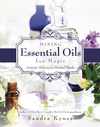An Aromatic Wheel of the Year

While to some people the use of essential oils may seem more New Age or pop culture than Pagan, oils come from plants—and down through the ages Witches and Pagans have used plants for magic and ritual. Using essential oils is a way to hold tradition while extending our practices and giving them new depth. I like to refer to the blending of oils for magic and ritual as "aromatic alchemy," because we transform the power of plant aromas into magical messengers for our purposes. I usually avoid the term "aromatherapy" when using oils for ritual or magic because the word "therapy" implies that something is broken and needs to be fixed. We are not providing therapy to our magic, rituals, or divination when we use essential oils. Instead, we are using the oils to aid us in transforming our practices and breathing life into our intentions.
Through the alchemy of scent, aromas can retrieve a total experience of feelings, imagery, and sounds. Essential oils provide immediate access to a rich storehouse of memory and emotion, which are the deeper parts of the self that reach into the soul. Just as scent can trigger memory, using specific fragrances for ritual and magic helps us to return to a certain level of consciousness where we can pick up where we left off. It can help us build on our ritual experiences and deepen divination, psychic, or shamanic work. While the ancients may not have understood the mechanics of the olfactory system, they understood how to work with it. The use of scent in ritual and religious practices cuts across cultures, traditions, beliefs, and time. The purpose of incense in the earliest of rituals was to communicate with deities as well as the spirit world.
The most basic reason to work with essential oils is that they keep us in touch with the natural world, no matter where we live—even a Manhattan high-rise. With essential oils we use the very essence of plants—their core and spirit—which makes them valuable for magic work. While we can boost the effectiveness of our spells and rituals with the life essence that these oils carry, using them in our homes for mundane applications also helps keep us in tune with the turning of the seasons.
In ritual and magic work, we often use various parts of plants because of their symbolism, which in turn enhances the energy and power of our intentions. It doesn't take any stretch of the imagination to see that using an essential oil or blend of oils in place of an actual piece of plant works just as well. In addition to covering three standard methods for blending oils in my book, Mixing Essential Oils for Magic, I introduce my own method, which is based on the various parts of plants. Working with oils from specific plant parts can also help us create seasonal scents. Think of it as an "Aromatic Wheel of the Year."
While we may think of flowers as providing fragrance, scents are produced in many other parts of plants. For example, sandalwood oil comes from the wood, bark, and roots; juniper oil from fruit; lemon balm from leaves and flowers; and frankincense from the oleoresin. Oil also comes from stems, twigs, seeds, and nuts. For my personal practice and in my book, I took into consideration the plant parts used for producing oil and came up with nine categories:
- Flowers
- Fruit
- Leaves
- Leaves and flowers (some oils are produced from a combination of these)
- Resins (which includes oleoresins and gums)
- Foots (which includes rhizomes [a type of root])
- Seeds (which includes nuts and kernels)
- Twigs and leaves
- Wood and bark
For an Aromatic Wheel of the Year, I assigned these categories to the seasons:
- Spring: Flowers, leaves, flowers and leaves, resins, seeds
- Summer: Flowers, leaves, flowers and leaves, fruit, roots, seeds, twigs and leaves
- Autumn: Fruit, leaves, wood and bark, seeds, twigs and leaves
- Winter: Foots, wood and bark, seeds and the leaves and twigs of evergreens
Quite naturally, there will be some overlaps, but like the seasons this creates a flow of scents. In spring the earth awakens and life bursts forth from seeds that have been cradled in the soil. Resins give an earthy smell in the spring and reminds us that the soil is ready to be planted. As energy quickens and flows, so do the resins, which I think of as the life blood of plants. The other categories that I include for spring are leaves and flowers. As we move into summer more flowers and leaves green our gardens accompanied by fruit and seeds, and the growth of twigs and roots. In autumn fruit and nuts are abundant, but leaves blaze into their final glory and then fade revealing more of the wood and bark of trees and roots. Finally the quiet of winter descends with seeds tucked into the ground once again among the roots. Of course there are exceptions, especially around Yule, as there are many aromas that we associate with the season. For example, citrus and clove oils are reminiscent of the orange pomanders.
As a new season begins, pick a few oils with which you are familiar to create a scent. In summer, try a combination of lavender, patchouli, and orange, which come from flowers, leaves, and fruit, respectively. Lavender carries the sweetness of summer, patchouli has the rich fullness of warm earth, and orange brings the delight of abundance. For autumn, pine (twigs and leaves), sage (leaves), and juniper (fruit) provides a combination that is deep, warming, and comforting. It speaks of brilliant fall days and chilly nights as it imparts a cozy feeling of evenings by the fireplace.
Before embarking on your aromatic journey into a season, create sacred space and sit in front of your altar. Visualize what the current season means to you. What are the emotions and sensations that it evokes? Don't think about it—feel it, let intuition guide you, and then write down your impressions. A list of keyword will do. Now comes the fun part: look at the listings of oils by seasons. Pick a few that symbolize or echo the sentiments of the keywords you have written.
The following seasonal tables provide listings of popular oils according to my plant part categories and are intended to provide you with a starting point. These tables also provide information on the oils that blend well together; however, there are many others that also blend well. Take your time and experiment to find the oils and combinations of oils that speak to your soul and provide that aromatic alchemy for your magic.
Spring Oils
| Flowers | Other Flowers | Leaves | Leaves and Flowers | Resins | Seeds |
| cananga | jasmine | citronella | lemon balm | labdanum | cardamom |
| catnip | peppermint | eucalyptus (blue gum) | rosemary | myrrh | |
| chamomile (German) | neroli | patchouli | marjoram | benzoin | |
| chamomile (Roman) | rose | tarragon | clary sage | frankincense | cumin |
| clove | lavandin | allspice | rosemary | nutmeg | |
| helichrysum | chamomile (Roman) | lemongrass | lemon balm | labdanum | cardamom |
| hops | lavender | myrtle | lemon balm | nutmeg | |
| jasmine | spearmint | birch | clary sage | storax | coriander |
| lavandin | clove | citronella | thyme | storax | |
| lavender (spike) | rose | sage | rosemary | elemi | caraway |
| lavender (true) | spearmint | patchouli | clary sage | frankincense | |
| neroli | ylang-ylang | patchouli | clary sage | opopanax | coriander |
| oregano | lavandin | citronella | rosemary | ||
| peppermint | lavender | eucalyptus (blue gum) | marjoram | benzoin | dill |
| rose (Damask) | jasmine | palmarosa | lemon balm | sandalwood | fennel (sweet) |
| rose (Maroc) | clove | patchouli | clary sage | sandalwood | fennel (sweet) |
| spearmint | lavandin | eucalyptus (blue gum) | basil | ||
| ylang-ylang | neroli | birch | lemon balm | sandalwood | cardamom |
Summer Oils (includes the spring oils)
| Flowers | Roots | Fruit | Twigs and Leaves |
| cananga | sandalwood | bergamot | |
| catnip | lime | eucalyptus (lemon) | |
| chamomile (German) | lemon | tea tree | |
| chamomile (Roman) | bergamot | tea tree | |
| clove | sandalwood | grapefruit | cajeput |
| helichrysum | vetiver | litsea | tea tree |
| hops | lemon | pine | |
| jasmine | vetiver | mandarin | petitgrain |
| lavandin | lovage | lime | bay |
| lavender (spike) | vetiver | lemon | petitgrain |
| lavender (true) | vetiver | orange | pine |
| neroli | ginger | orange | peitgrain |
| oregano | bergamot | pine | |
| peppermint | lemon | niaouli | |
| rose (Damask) | ginger | bergamot | eucalyptus (lemon) |
| rose (Maroc) | ginger | bergamot | eucalyptus (lemon) |
| spearmint | mandarin | ||
| ylang-ylang | vetiver | bergamot | tee tree |
Autumn Oils
| Leaves | Other Leaves | Wood and Bark | Twigs and Leaves | Fruit | Seeds |
| allspice | patchouli | bay | orange | coriander | |
| birch | clove | pine | juniper | ||
| cassia | clove | grapefruit | coriander | ||
| cinnamon | clove | cedarwood (Atlas) | spruce | orange | caraway |
| citronella | sage (common) | cedarwood (any type) | pine | bergamot | coriander |
| clove | cassia | sandalwood | bay | grapefruit | nutmeg |
| dill | lemongrass | petitgrain | orange | cardamom | |
| eucalyptus (blue gum) | sage (Spanish) | cedarwood (any type) | cajeput | lemon | anise |
| fir (balsam) | tarragon | cedarwood (any type) | cypress | juniper | coriander |
| lemongrass | dill | cedarwood (any type) | tea tree | bergamot | |
| myrtle | clove | bay | lime | ||
| palmarose | clove | amyris | eucalyptus (lemon) | grapefruit | cardamom |
| patchouli | allspice | sandalwood | fir (silver) | bergamot | angelica |
| sage (common) | pine | lemon | |||
| sage (Spanish) | eucalyptus (blue gum) | cedarwood (any type) | pine | juniper | |
| tarragon | fir (silver) | pine | juniper | carrot |
Winter Oils
| Roots | Other Roots | Wood and Bark | Twigs and Leaves | Seeds |
| angelica | cedarwood (any type) | pine | coriander | |
| galangal | cinnamon | pine | parsley | |
| ginger | vetiver | sandalwood | coriander | |
| lovage | celery | |||
| sandalwood | ginger | cypress | ||
| snakeroot | vetiver | sandalwood | pine | coriander |
| spikenard | vetiver | cypress | dill | |
| turmeric | ginger | nutmeg | ||
| valerian | cedarwood (any type) | |||
| vetiver | spikenard | sandalwood | angelica |

About Sandra Kynes
Related Products


is subject to certain Terms and Conditions